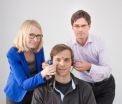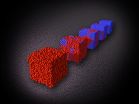(Press-News.org) ANN ARBOR, Mich. — Dating during the teen years takes a violent turn for nearly 1 in 6 young people, a new study finds, with both genders reporting acts like punching, pulling hair, shoving, and throwing things.
The startling number, drawn from a University of Michigan Medical School survey of more than 4,000 adolescent patients ages 14 to 20 seeking emergency care, indicates that dating violence is common and affects both genders.
Probing deeper, the study finds that those with depression, or a history of using drugs or alcohol, have a higher likelihood to act as the aggressor or victim.
The findings, from the largest-ever study of the issue in a health care setting, suggests a need for health care providers to ask both young women and men about whether their relationships have ever turned violent, and to guide them to resources. The results are published online in the Annals of Emergency Medicine.
"It's important to think about both genders when trying to identify teen dating violence, especially when there are other conditions we may be trying to assess in the health care setting," says Vijay Singh, M.D., MPH, MS, the study's lead author and a U-M clinical lecturer in the Departments of Emergency Medicine and Family Medicine.
"These data remind us that teen relationships are not immune to violence and should encourage providers to ask adolescent patients about this important issues," he adds. "In addition, this could help us understand whom to target for screening and referral to, or development of, programs that could help them."
Relationships in adolescence set up patterns for adult relationships, he notes. Intervening with adolescents experiencing dating violence is crucial to prevent adult intimate partner violence.
Singh and his colleagues at the U-M Injury Center analyzed data from a larger survey of teens and young adults aged 14 to 20 years who visited the U-M Health System's emergency department for any reason between late 2010 and early 2013. The teens took the surveys on touch-screen tablet computers in private, though those under age 18 needed their parents' consent to take part.
While the researchers didn't ask about the gender of the teen's partner or about emotional or sexual abuse, the new data give new insight into teen dating violence that builds on school-based and smaller healthcare-based studies.
In all, 1 in 5 young women said they had been the victim or aggressor in a violent situation in the last year with a romantic partner, and 1 in 8 young men reported the same, suggesting that Emergency Departments can aid in identifying dating violence.
Interestingly, teen girls who had sought emergency care for an intentional injury in the last year had twice the odds of reporting violence in their dating relationships.
That finding, Singh says, lends credence to the idea that the ED could be an important site for screening.
"We may ask 'How did you get that injury?,' but often if someone has been a victim of violence, they don't want to disclose that, and it takes repeated questioning in a sensitive way to find out more," he explains.
He notes that, last year, the top national panel for preventive health services recommended that all women between the ages of 14 and 46 be asked about relationship violence during health care visits.
But the lack of data on men as both victims and aggressors means there isn't a similar recommendation for screening them. The new study, he hopes, will add to the understanding of how dating violence affects young men.
"This affects people of both genders, so let's assess them both," Singh says. "Especially in the teen years, when young people are figuring out their relationship roles, changing partners more often than adults, and likely not living together."
His colleagues and co-authors on the new study, Maureen Walton, Ph.D., MPH, of the U-M Department of Psychiatry, and Injury Center director Rebecca Cunningham, M.D., of the U-M Department of Emergency Medicine, are testing a behavioral intervention tool in urban emergency departments that aims to help teens understand how to reduce violence of all kinds in their lives.
Singh also co-wrote guidance on screening for intimate partner violence for primary care providers, published in the June issue of Primary Care: Clinics in Office Practice.
Singh urges all teens, and those who love them, to be aware of phone and online resources that can help them identify and respond to unhealthy tendencies in their relationships – and get help when things threaten to turn violent.
That includes the toll-free, 24-hour, multi-language National Domestic Violence Hotline, 800-799-SAFE and its website http://www.ndvh.org, as well as Love is Respect, http://www.loveisrespect.org, which focuses on teens.
INFORMATION:
In addition to Singh, Walton and Cunningham, the study's authors include Lauren K. Whiteside, MD, MS, Sarah Stoddard, Ph.D., Quyen Epstein-Ngo, Ph.D. and Stephen T. Chermack, Ph.D. Singh, Walton and Cunningham are all members of the U-M Institute for Healthcare Policy and Innovation.
Funding for the study came from National Institute on Alcoholism and Alcohol Abuse (grant AA018122, with additional support from the U-M injury Center, which is supported by the Centers for Disease Control and Prevention (grant 5R49CE002099).
Reference: Annals of Emergency Medicine, http://dx.doi.org/10.1016/j.annemergmed.2014.05.027
Primary Care: Clinics in Office Practice: http://www.sciencedirect.com/science/article/pii/S0095454314000098
Teen dating violence cuts both ways: 1 in 6 girls and guys are aggressors, victims or both
ER-based study reinforces need for screening to get teens help
2014-07-07
ELSE PRESS RELEASES FROM THIS DATE:
Taking a short smartphone break improves employee well-being, research finds
2014-07-07
MANHATTAN, KAN. — Want to be more productive and happier during the workday? Try taking a short break to text a friend, play "Angry Birds" or check Facebook on your smartphone, according to Kansas State University research.
In his latest research, Sooyeol Kim, doctoral student in psychological sciences, found that allowing employees to take smartphone microbreaks may be a benefit — rather than a disruption — for businesses. Microbreaks are nonworking-related behaviors during working hours.
Through a study of 72 full-time workers from various industries, Kim discovered ...
Sleep deprivation leads to symptoms of schizophrenia
2014-07-07
Twenty-four hours of sleep deprivation can lead to conditions in healthy persons similar to the symptoms of schizophrenia. This discovery was made by an international team of researchers under the guidance of the University of Bonn and King's College London. The scientists point out that this effect should be investigated more closely in persons who have to work at night. In addition, sleep deprivation may serve as a model system for the development of drugs to treat psychosis. The results have now been published in "The Journal of Neuroscience".
In psychosis, there is ...
Study reveals strong links between Antarctic climate, food web
2014-07-07
A long-term study of the links between climate and marine life along the rapidly warming West Antarctic Peninsula reveals how changes in physical factors such as wind speed and sea-ice cover send ripples up the food chain, with impacts on everything from single-celled algae to penguins.
The study, published in today's issue of Nature Communications, is authored by Dr. Grace Saba, an alumna of William & Mary's Virginia Institute of Marine Science (now at Rutgers University); VIMS professor Deborah Steinberg; Dr. Vincent Saba, a VIMS alumnus now at NOAA's National Marine ...
NYU researchers tackle racial/ethnic disparities in HIV medical studies
2014-07-07
A New York University College of Nursing (NYUCN) research team found that a social/behavioral intervention vastly increased the number of African American and Latino individuals living with HIV/AIDS who enrolled in HIV/AIDS medical studies. The intervention, designed by researchers at the NYUCN's Center for Drug Use and HIV Research (CDUHR), found that nine out of ten participants who were found eligible for studies decided to enroll, compared to zero participants among a control group.
The study, called "ACT2," addresses a long-recognized problem: the racial/ethnic ...
Support team aiding caregivers of cancer patients shows success, CWRU researchers report
2014-07-07
Many caregivers of terminal cancer patients suffer depression and report regret and guilt from feeling they could have done more to eliminate side effects and relieve the pain.
So researchers from the nursing school at Case Western Reserve University devised and tested an intervention that quickly integrates a cancer support team to guide caregivers and their patients through difficult end-of-life treatment and decisions.
In the study, caregivers reported a high degree of satisfaction from having a team comprised of an advance practice nurse, social worker, a spiritual ...
Does cycling increase risk for erectile dysfunction, infertility, or prostate cancer?
2014-07-07
New Rochelle, NY, July 7, 2014—Cycling is a popular activity that offers clear health benefits, but there is an ongoing controversy about whether men who ride have a higher risk of urogenital disorders such as erectile dysfunction, infertility, or prostate cancer. The results of a study of nearly 5,300 male cyclists who participated in the Cycling for Health UK Study are presented in an article in Journal of Men's Health, a peer-reviewed publication from Mary Ann Liebert, Inc., publishers. The article is available free on the Journal of Men's Health website at http://online.liebertpub.com/doi/full/10.1089/jomh.2014.0012 ...
Alzheimer's disease: Simplified diagnosis, with more reliable criteria
2014-07-07
This news release is available in French. How many patients receive an incorrect diagnosis of Alzheimer's disease? The answer is a surprisingly high number: over a third! To reduce the number of errors, the diagnostic criteria must be the most reliable possible, especially at the very early stages of the disease. For the last decade, an international team of neurologists, coordinated by Bruno Dubois (Inserm/Pierre and Marie Curie University/AP-HP Joint Research Unit 975) has been working towards this. In the June issue of The Lancet Neurology journal, we see how the ...
R.I. lead law effective, often ignored
2014-07-07
PROVIDENCE, R.I. [Brown University] — When landlords have followed Rhode Island's law requiring them to protect tenants from exposure to lead, their compliance has significantly reduced blood levels of the toxic metal in children. But in four of the state's major cities, only 20 percent of properties that are covered by the law were in compliance with the law even more than four years after it took effect, according to a study by researchers at Brown University, The Providence Plan, HousingWorks RI, and the Rhode Island Department of Health.
"The law works when it is ...
College athletes with abusive coaches more willing to cheat
2014-07-07
WASHINGTON — College athletes who have abusive coaches are more willing to cheat in order to win than players with more ethical coaches, according to new research published by the American Psychological Association and based on surveys from almost 20,000 student athletes at more than 600 colleges across the country.
"Ethical behavior of coaches is always in the spotlight," said lead researcher Mariya Yukhymenko, PhD, a visiting research associate at the University of Illinois at Chicago. "Our study found several negative effects related to abusive coaches, including ...
Penn researchers: Consider the 'anticrystal'
2014-07-07
For the last century, the concept of crystals has been a mainstay of solid-state physics. Crystals are paragons of order; crystalline materials are defined by the repeating patterns their constituent atoms and molecules make.
Now physicists at the University of Pennsylvania and the University of Chicago have evidence that a new concept should undergird our understanding of most materials: the anticrystal, a theoretical solid that is completely disordered.
Their work suggests that, when trying to understand a real material's mechanical properties, scientists would be ...
LAST 30 PRESS RELEASES:
Duke and Duke-NUS’ joint cross-population research to uncover "East-West" differences in disease and care
Scientists to ‘spy’ on cancer- immune cell interactions using quantum technology breakthrough
Tech savvy users have most digital concerns
Making lighter work of calculating fluid and heat flow
Normalizing blood sugar can halve heart attack risk
Lowering blood sugar cuts heart attack risk in people with prediabetes
Study links genetic variants to risk of blinding eye disease in premature infants
Non-opioid ‘pain sponge’ therapy halts cartilage degeneration and relieves chronic pain
AI can pick up cultural values by mimicking how kids learn
China’s ecological redlines offer fast track to 30 x 30 global conservation goal
Invisible indoor threats: emerging household contaminants and their growing risks to human health
Adding antibody treatment to chemo boosts outcomes for children with rare cancer
Germline pathogenic variants among women without a history of breast cancer
Tanning beds triple melanoma risk, potentially causing broad DNA damage
Unique bond identified as key to viral infection speed
Indoor tanning makes youthful skin much older on a genetic level
Mouse model sheds new light on the causes and potential solutions to human GI problems linked to muscular dystrophy
The Journal of Nuclear Medicine ahead-of-print tip sheet: December 12, 2025
Smarter tools for peering into the microscopic world
Applications open for funding to conduct research in the Kinsey Institute archives
Global measure underestimates the severity of food insecurity
Child survivors of critical illness are missing out on timely follow up care
Risk-based vs annual breast cancer screening / the WISDOM randomized clinical trial
University of Toronto launches Electric Vehicle Innovation Ontario to accelerate advanced EV technologies and build Canada’s innovation advantage
Early relapse predicts poor outcomes in aggressive blood cancer
American College of Lifestyle Medicine applauds two CMS models aligned with lifestyle medicine practice and reimbursement
Clinical trial finds cannabis use not a barrier to quitting nicotine vaping
Supplemental nutrition assistance program policies and food insecurity
Switching immune cells to “night mode” could limit damage after a heart attack, study suggests
URI-based Global RIghts Project report spotlights continued troubling trends in worldwide inhumane treatment
[Press-News.org] Teen dating violence cuts both ways: 1 in 6 girls and guys are aggressors, victims or bothER-based study reinforces need for screening to get teens help






